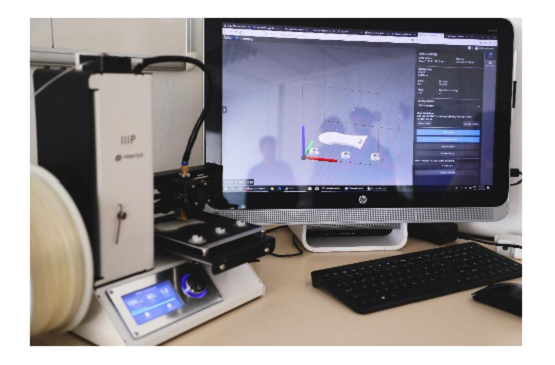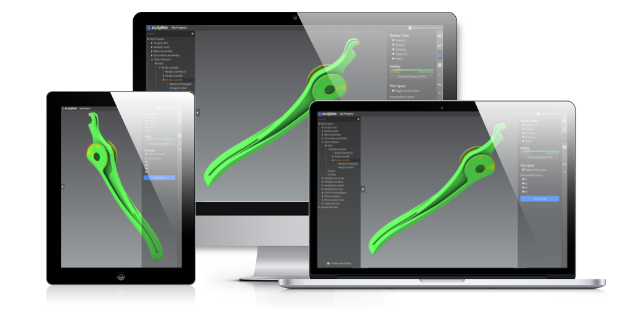Sculpteo publishes State of 3D Printing 2020 survey: 3D printing for production increases
BASF Doubles Down on 3D Printing, Buys Sculpteo
BASF has really shaken up the 3D printing industry yet again by buying Sculpteo today. The German chemical giant has previously bought Dutch filament leader Innofill3D, launched a new brand and materials, invested together with Materialise in Essentium, invested in Prismlab, invested in Materialise and bough Advance3D and Setup Solutions. Whereas a few years ago it was 3D Systems that was keeping the M&A lawyers in suits now it seems that dueling polymer firms BASF and DSM are trying to out invest each other in the space. It is these two companies that are making the biggest splashes of late.

Rear-view mirror housing made from BASF Ultrasint PA6 X043 with Farsoon HT403P.
Dr. Dietmar Bender, Managing Director BASF 3D Printing Solutions says,
“Through the acquisition of Sculpteo, we can provide customers and partners with even faster access to our innovative 3D printing solutions. In addition, our customers will benefit from an extended range of services.” “Together with Sculpteo, we are pursuing our goal of establishing additive manufacturing as a proven technology for industrial mass production”
“We are excited to join the BASF team and thus benefit from BASF’s outstanding R&D to provide our customers with innovative solutions”, says Clément Moreau, Sculpteo CEO
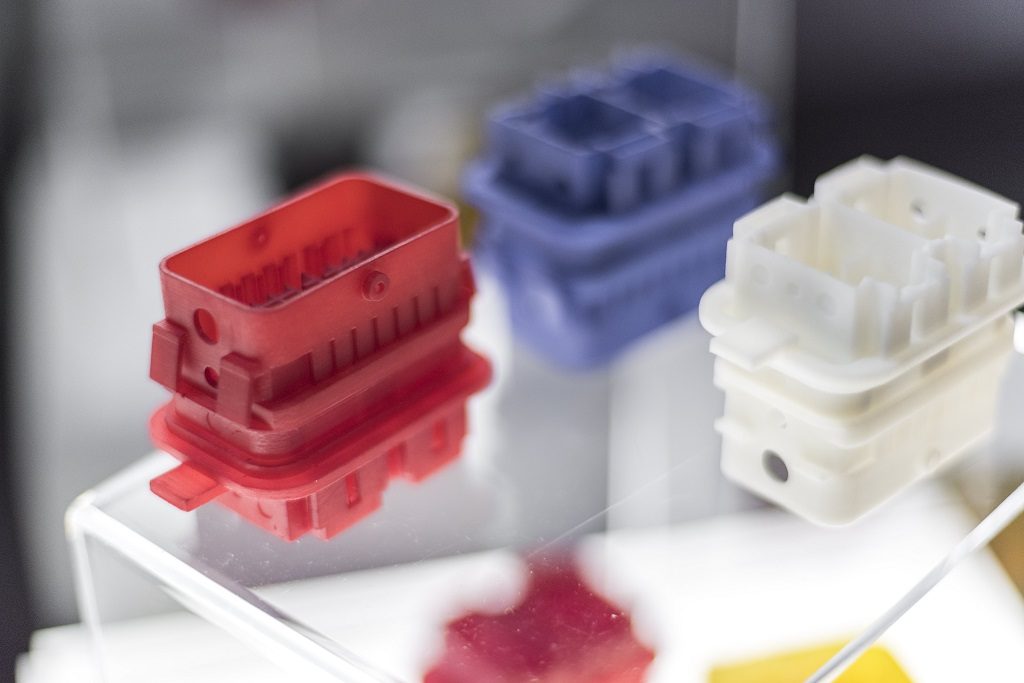
BASF Photo-Resin X004M
Terms were not disclosed but the impact of this move will be significant.
- BASF is now in the parts business not just in the chemicals business. Does this mean that they will make more parts outside of 3D printing as well? We’ve seen moves as well by Victrex, makes of PEEK, to move from relatively low-value chemistry and polymers towards parts manufacturing. If this trend continues it has a lot of broad implications for many BASF suppliers and customers.
- Materialise now has BASF as a partner and investor as well as through Sculpteo as a competitor with 3D printing as a service, this is awkward to say the least and may strain the partnership. If BASF communicated this acquisition well then this should not be an issue.
- Will this mean that DSM could buy Shapeways to put itself in the driving seat once again? Or would Shapeways be too expensive?
- Perhaps this will unlock a roll-up strategy for some market player by making it valuable for them to buy a series of local service bureaus.
- What will Quickparts and Stratasys direct (and other services) do when faced with a company that wants to sell them materials while competing with them? Will services not buy BASF materials any longer? After all, more money for BASF may mean more investment in the highest margin part of their business and this is now Sculpteo.
- What will other materials firms such as SABIC and Solvay do? Will they be forced to partner with services as well or take another route and be super platform agnostic?
- Will this mean that more OEMs such as HP will invest in platforms as well?
- With GKN buying Forecast will we now see a global battle between truly international services?
- For Evonik, this will mean loss of the Sculpteo volume but do they stand to lose more if others take over platforms as well?
- For Xometry and others, this means that reinvestment prospects have dimmed slightly because investors must be slightly weary to play in the same backyard as manufacturing giants such as GKN and Jabil as well as a chemicals to polymers to parts company such as BASF.
- Addup wasn’t interested in buying a French 3D printing company, who knew?
- Does this mean that our industry is just a stress ball for large polymer companies? Are the big polymer firms the only players that count now in 3D printing for polymers?

Is this a good deal?
For Sculpteo this exit seems like it was the maximum achievable. Clement and his team have fought hard for years to make Sculpteo more international and to compete with Shapeways, Materialise and others. Assumptions by investors are all based on the assumption that winner takes all. The truth is likely more nuanced, but Clement and his team get a well-earned exit plus lots of skill and polymer expertise to build their business within BASF. We won’t know the purchase price but it seems a solid move rather than trying to wait it out another year and risk getting crushed by new entrants.
For BASF this is an astute move. Higher margin, closer to the customer businesses could give them an edge. I’ve always considered BASF quietly weak in 3D printing because they don’t really understand customers or applications and always insulate themselves from them. By getting in closer they could develop more consumer-friendly and application-ready materials directly. Of all the polymer companies I’ve considered BASF to be brave with their money but the firm has a decided lack of understanding in customer needs and applications when compared to DSM, Sabic, Lehmann Voss, Mitsubishi, and others. Information now flows more directly to and through BASF which may help them. If we look at the bigger picture in polymers then moving from chemicals towards parts puts them at a much better point in the chain and improves their prospects long term.
The post BASF Doubles Down on 3D Printing, Buys Sculpteo appeared first on 3DPrint.com | The Voice of 3D Printing / Additive Manufacturing.
Sculpteo and Netlooks put custom eyewear to the test with 3D printing
Deloitte Global report predicts 3D printing’s “plateau of productivity” in 2019
3D printing news Sliced: CERN, HP Foundation, APWORKS, Phrozen, Etch-a-Sketch
Sculpteo Earns ISO 9001 Standard, Partners with Bombardier
3D printing service Sculpteo has announced that is has obtained the ISO 9001:2015 standard. As defined by the International Standards Organization (ISO), this standard specifies requirements for a quality management system when an organization
- needs to demonstrate its ability to consistently provide products and services that meet customer and applicable statutory and regulatory requirements
- aims to enhance customer satisfaction through the effective application of the system, including processes for improvement of the system and the assurance of conformity to customer and applicable statutory and regulatory requirements
 The standard is granted exclusively to companies that can prove that they have implemented efficient and documented protocols to ensure both continuous improvement and quality of service in communicating with clients. It certifies quality management systems that are geared towards improvement, client satisfaction and the active involvement of executive management and employees in a process-based approach.
The standard is granted exclusively to companies that can prove that they have implemented efficient and documented protocols to ensure both continuous improvement and quality of service in communicating with clients. It certifies quality management systems that are geared towards improvement, client satisfaction and the active involvement of executive management and employees in a process-based approach.
![]() Earning this standard means that Sculpteo can now partner with some of the largest industrial companies in the world, such as Bombardier, the leading manufacturer of both planes and trains. Bombardier uses additive manufacturing to create complex parts which act as a mount for different instrumentations of fatigue tests, such as comparators, pulleys and targets, as well as aeraulics such as reheater copies and acoustics like acoustical racquets, microphone mounts and guides for the positioning of microphones.
Earning this standard means that Sculpteo can now partner with some of the largest industrial companies in the world, such as Bombardier, the leading manufacturer of both planes and trains. Bombardier uses additive manufacturing to create complex parts which act as a mount for different instrumentations of fatigue tests, such as comparators, pulleys and targets, as well as aeraulics such as reheater copies and acoustics like acoustical racquets, microphone mounts and guides for the positioning of microphones.
“We are regularly let to manufacture in 3D printing parts that are essential in our measuring process,” said Stéphane Veste, Testing Engineer in the Product Integrity Test Pole of Bombardier Transport France. “We rely on rules that compel us to a certain rigor regarding, amongst others, the positioning of the sensors, a phase where we use the 3D-printed parts (acoustical racquet, microphone mount, positioning tools in relation to the path median etc). The quality of these tools contributed to the obtainment of the RFU-022 standard.”
The ISO 9001 standard covers all activities in 3D printing, consulting, design and engineering at Sculpteo for one year.
“Only yesterday was 3D printing considered an imperfect technology; it has now become a tool opened not only to some pioneers, but an asset of the largest industrial companies,” said Clément Moreau, CEO of Sculpteo. “Obtaining the ISO 9001-2015 standard is the result of a process that mobilized all of Sculpteo’s skills. It certifies the level of quality and precision of its different 3D printing services, which suit the most demanding manufacturing process of the upper industries.”
Sculpteo was founded in 2009 by Moreau and Eric Careel. In the nearly 10 years the company has been in business, it has accrued customers from all around the world. Sculpteo has locations based in both Paris and San Francisco, and its offerings include on-demand 3D printing for clients ranging from startups to SMEs and design studios.
Discuss this and other 3D printing topics at 3DPrintBoard.com or share your thoughts below.
3D Printing News Briefs: October 13, 2018
We’ve got business and education news galore in today’s 3D Printing News Briefs. First, Voodoo Manufacturing has launched its new Shopify app, and BeAM Machines is partnering with Empa, while Sculpteo is working with a property developer to provide 3D printed apartment models. VSHAPER has signed an agreement with educational publisher Grupa MAC, and the United Arab Emirates is introducing 3D printing into over 200 of its primary schools. The US Navy will be testing the first 3D printed ship component, and Lufthansa Technik has established a new Additive Manufacturing Center. Finally, maker Thomas Sanladerer shared on YouTube about his recent visit to the Prusa headquarters.
Voodoo Manufacturing Launches Shopify App
 This spring, high-volume 3D printing factory Voodoo Manufacturing began its full-stack manufacturing and fulfillment service for 3D printing entrepreneurs, which allows users to outsource work like quality control and assembly for their products through its easy shopfront integrations with online marketplaces like Shopify. Now, the company has launched its own Shopify app, which will allow online sellers to create and customize 3D printed products and sell them on their own Shopify stores. Once the app is installed, users can make their first product in less than 5 minutes, which is then automatically added to their store, ready for purchase.
This spring, high-volume 3D printing factory Voodoo Manufacturing began its full-stack manufacturing and fulfillment service for 3D printing entrepreneurs, which allows users to outsource work like quality control and assembly for their products through its easy shopfront integrations with online marketplaces like Shopify. Now, the company has launched its own Shopify app, which will allow online sellers to create and customize 3D printed products and sell them on their own Shopify stores. Once the app is installed, users can make their first product in less than 5 minutes, which is then automatically added to their store, ready for purchase.
“We wanted to make it ridiculously easy for ecommerce stores to diversify their product offering with 3D printed products. By applying 3D printing to the print-on-demand business model, we are opening up an infinite range of product categories for Shopify merchants,” said Max Friefeld, the Founder and CEO of Voodoo Manufacturing. “The Voodoo app provides a new source of high quality, customizable, on-demand products, that don’t require any 3D design experience.”
Before the official launch this week, Voodoo piloted the service with a group of beta users, including It’s The Island Life by graphic designer and Guam native Lucy Hutcheson. She is already successfully selling six different products made with the help of the new Voodoo app.
BeAM Machines Partnering with Empa
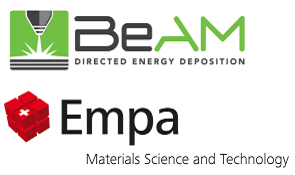 BeAM, recently acquired by AddUp, has signed a research and development agreement with Empa, the Swiss Federal Laboratories for Materials Science and Technology. Together, the two will develop novel applications for BeAM’s powder-based Directed Energy Deposition (DED) technology, which uses focused thermal energy to fuse materials by melting them while they’re deposited. This makes parts manufacturing much faster. The partnership has come on the heels of Empa’s acquisition of a BeAM DED 3D printer, which is located at its Laboratory for Advanced Materials Processing in Thun and is used to integrate and test out innovative components.
BeAM, recently acquired by AddUp, has signed a research and development agreement with Empa, the Swiss Federal Laboratories for Materials Science and Technology. Together, the two will develop novel applications for BeAM’s powder-based Directed Energy Deposition (DED) technology, which uses focused thermal energy to fuse materials by melting them while they’re deposited. This makes parts manufacturing much faster. The partnership has come on the heels of Empa’s acquisition of a BeAM DED 3D printer, which is located at its Laboratory for Advanced Materials Processing in Thun and is used to integrate and test out innovative components.
Patrik Hoffmann, who leads the laboratory, said, “We are very excited to collaborate with BeAM’s engineers to push the boundaries of this innovative additive manufacturing technology and to develop a whole new range of applications for Swiss industries and beyond.”
Sculpteo 3D Printing Apartment Models
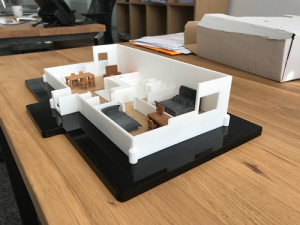 Together with Sculpteo, French property developer Valoptim is working to improve customer experience by providing clients with miniaturized 3D printed models of their future apartments when they sign their contracts, so they can better visualize and prepare for moving into their new home. These small, exact replicas give new owners an immersive experience, which is a definite value add. In addition, production of the 3D printed models is local, and can be done fast.
Together with Sculpteo, French property developer Valoptim is working to improve customer experience by providing clients with miniaturized 3D printed models of their future apartments when they sign their contracts, so they can better visualize and prepare for moving into their new home. These small, exact replicas give new owners an immersive experience, which is a definite value add. In addition, production of the 3D printed models is local, and can be done fast.
“Sculpteo uses the best machines and 3D printing processes on the market today. At first, we had the ambition to test the feasibility of 3D printing in the real estate sector. This innovative process has proven to be extremely interesting: the realistic rendering, with high-end finishes, allowed our clients to discover a miniaturized version of their future apartment enabling them to realistically imagine themselves living in it,” said Edouard Pellerin, CEO of Valoptim. “This innovation contributes to our business dynamic: constantly improving the customer experience.”
VSHAPER and Grupa Mac Sign Agreement
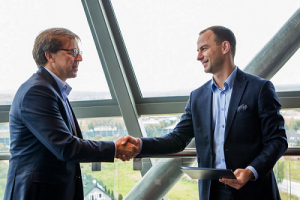 Polish 3D printer manufacturer Verashape has signed an agreement with Grupa MAC, the country’s top educational publisher, in front of Poland’s education curators at the recent Future of Education Congress. Per the agreement, Grupa MAC will use a network of educational consultants to distribute the VSHAPER GO 3D printers to kindergartens and other schools in the country. Grupa MAC recognizes that 3D printers are a good way to quickly present the effects of students’ learning, and the VSHAPER GO is the perfect choice, as it is easy to use and comes with an intuitive interface of SOFTSHAPER software.
Polish 3D printer manufacturer Verashape has signed an agreement with Grupa MAC, the country’s top educational publisher, in front of Poland’s education curators at the recent Future of Education Congress. Per the agreement, Grupa MAC will use a network of educational consultants to distribute the VSHAPER GO 3D printers to kindergartens and other schools in the country. Grupa MAC recognizes that 3D printers are a good way to quickly present the effects of students’ learning, and the VSHAPER GO is the perfect choice, as it is easy to use and comes with an intuitive interface of SOFTSHAPER software.
“Classes with students are a perfect environment for the use of 3D Printing. Creating a pyramid model for history lessons, the structure of a flower or a human body for biology lessons are just a few examples, and their list is limited only by the imagination of students and teachers,” said Patryk Tomczyk, a member of the Grupa MAC Management Board. “We are happy that thanks to our cooperation with VERASHAPE, 3D Printers have a chance to reach schools through our network of educational consultants.”
3D Printing to be Introduced in UAE Primary Schools
 Speaking of 3D printing in education, the Ministry of Education (MoE) for the UAE has announced that in early 2019, a country-wide introduction of 3D printing into over 200 primary schools will commence. As part of this new technology roll out, Dubai education consultancy company Ibtikar is partnering with Makers Empire, an Australian education technology company, to deliver a program that implements 3D printing and design. Makers Empire will supply 3D software, curriculum, teacher resources, training, and support to Ibtikar, which will in turn train MoE teachers to deliver the program.
Speaking of 3D printing in education, the Ministry of Education (MoE) for the UAE has announced that in early 2019, a country-wide introduction of 3D printing into over 200 primary schools will commence. As part of this new technology roll out, Dubai education consultancy company Ibtikar is partnering with Makers Empire, an Australian education technology company, to deliver a program that implements 3D printing and design. Makers Empire will supply 3D software, curriculum, teacher resources, training, and support to Ibtikar, which will in turn train MoE teachers to deliver the program.
“Through this rollout of 3D technology, our students will learn to reframe needs as actionable statements and to create solutions to real-world problems,” said HE Eng. Abdul Rahman of the United Arab Emirates Ministry of Education. “In doing so, our students will develop an important growth mindset, the skills they need to make their world better and the essential ability to persist when encountering setbacks.”
US Navy Approves Test of First 3D Printed Shipboard Part
The US military has long explored the use of 3D printing to lower costs and increase the availability of spare parts. Huntington Ingalls Industries, the largest military shipbuilder in the US, has also been piloting new technologies, like 3D printing, as part of its digital transformation. In collaboration with the US Navy, the company’s Newport News Shipbuilding division has worked to speed the adoption of 3D printed metal components for nuclear-powered warships. This has led to an exciting announcement by the Naval Sea Systems Command (NAVSEA): a metal drain strainer orifice (DSO) prototype has officially been approved as the first 3D printed metal part to be installed on a US Navy ship. The assembly is a component for the steam system, which allows for drainage and removal of water from a steam line while in use. The 3D printed DSO prototype will be installed on the USS Harry S. Truman in 2019 for evaluation and tests. After one year, the assembly will be removed for inspection and analysis.
“This install marks a significant advancement in the Navy’s ability to make parts on demand and combine NAVSEA’s strategic goal of on-time delivery of ships and submarines while maintaining a culture of affordability. By targeting CVN 75 [USS Harry S. Truman], this allows us to get test results faster, so-if successful-we can identify additional uses of additive manufacturing for the fleet,” said Rear Adm. Lorin Selby, NAVSEA Chief Engineer and Deputy Commander for Ship Design, Integration, and Naval Engineering.
Lufthansa Technik Opens New Additive Manufacturing Center
 Lufthansa Technik, a leading provider of maintenance, repair and overhaul (MRO) for civil aircraft, has established a new Additive Manufacturing Center. The goal of the new AM Center is to bundle and expand the company’s experience and competence with the technology, which can be used to make individual parts more quickly and with more design freedom. As the world of aircraft is always aware of weight, making more lightweight parts is an excellent benefit of 3D printing.
Lufthansa Technik, a leading provider of maintenance, repair and overhaul (MRO) for civil aircraft, has established a new Additive Manufacturing Center. The goal of the new AM Center is to bundle and expand the company’s experience and competence with the technology, which can be used to make individual parts more quickly and with more design freedom. As the world of aircraft is always aware of weight, making more lightweight parts is an excellent benefit of 3D printing.
“The new AM Center will serve as a collaborative hub where the experience and skills that Lufthansa Technik has gained in additive manufacturing can be bundled and further expanded,” said Dr. Aenne Koester, the head of the new AM Center. “The aim is to increase the degree of maturity of the technologies and to develop products that are suitable for production.”
Tom’s 3D Visits Prusa Headquarters
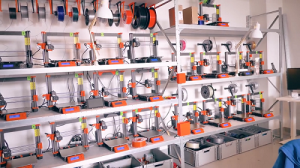 Maker Thomas Sanladerer, who runs his own YouTube channel, recently had the chance to tour the Prusa Research headquarters in Prague. Not only did he get the opportunity to see how the company makes its popular MK3 and and MK2.5, but Sanladerer was also able to see early models of the company’s recently announced SL1 resin 3D printer, as well as the Prusament filament production line.
Maker Thomas Sanladerer, who runs his own YouTube channel, recently had the chance to tour the Prusa Research headquarters in Prague. Not only did he get the opportunity to see how the company makes its popular MK3 and and MK2.5, but Sanladerer was also able to see early models of the company’s recently announced SL1 resin 3D printer, as well as the Prusament filament production line.
“I always find factory tours like this super interesting because it’s the only chance you really get of seeing behind the scenes of what might really just be a website, or you know, a marketing video or whatever,” Sanladerer said in his video.
Sanladerer took the tour of the Prusa factory right after Maker Faire Prague, which the company itself organized and sponsored. To see behind the scenes of Prusa for yourself, check out the rest of the video below:
Discuss these stories and other 3D printing topics at 3DPrintBoard.com or share your thoughts below.
Interview: Max Friefeld, CEO of Voodoo Manufacturing on Shopify, print farms and cookie cutters
Fabpilot by Sculpteo Demonstrating New FDM 3D Printing Integration at TCT Show
Last year, French 3D printing company Sculpteo first introduced its standalone Fabpilot software in October, before officially launching the fully cloud-based solution at formnext the month after. Now this week, at the 2018 TCT Show in Birmingham, Fabpilot by Sculpteo will be presenting its new Fused Deposition Modeling (FDM) integration – the software solution now directly connects to FDM 3D printers in order to optimize their production and handle industrial production.
Fabpilot is a Software as a Service (SaaS) and this update helps it serve professionals who own several FDM 3D printers and are looking for a better way to manage them. Especially in businesses where multiple users control the machines and need file security and traceability.
“Fabpilot aims to eliminate the insecure and error prone practices of physically moving data around,” explained Alex Gryson, Product Owner. “Machine integration such as with FDMs makes this a reality for any scale of lab or production facility.”
 It took Sculpteo eight years of in-house development to create Fabpilot, which provides third parties with a way to better manage and optimize their 3D printers. The software provides traceability, auto-routing for machine scheduling, streamlined file analysis and repair, file management and versioning, and a historical record of settings and configurations. The company claims that by using Fabpilot companies can increase overall production efficiency by 35%, and improve part quality.
It took Sculpteo eight years of in-house development to create Fabpilot, which provides third parties with a way to better manage and optimize their 3D printers. The software provides traceability, auto-routing for machine scheduling, streamlined file analysis and repair, file management and versioning, and a historical record of settings and configurations. The company claims that by using Fabpilot companies can increase overall production efficiency by 35%, and improve part quality.
Now, with its new direct FDM machine integration, Fabpilot is on a mission to support 3D printing for makerspaces, FabLabs, educational programs, universities, manufacturers and other businesses that provide 3D printing services. These can all use Fabpilot for direct integration with most FDM 3D printers, in order to combine file analysis and repair, quotation, part and order management, and performance analytics, as well as controlling end-to-end FDM production from the same cloud-based platform.
“FDM is by far the most common 3D printing technology: it’s cost-effective, highly adaptable, and the applications, from a microscopic scale to 3D printing houses, are endless. When thinking about the next progression, it made perfect sense to integrate directly with FDM,” said Clément Moreau, CEO and Co-Founder of Sculpteo and Fabpilot. “I am very proud of releasing this new functionality, which will bring a huge increase in the return-over investment ratio for users.”
With the new integration, Fabpilot users will be able to connect directly to FDM 3D printers and print from the cloud. It only takes a simple set-up and instance of Fabpilot to upload files, analyze and repair STLs, slice, and send G-code right to the FDM 3D printer. Some of the features the integration offers include:
- Multi-machine control: automatically assign jobs to available printers.
- 2D Nesting: arrange the maximum number of parts on the build plate while avoiding a collision to reduce the number of required jobs to print parts.
- Cloud slicing: upload over 30 file types, which are sliced and have their toolpaths defined so that G-code is ready to be sent to the printer.
- Optimize orientation: use Fabpilot’s current automatic orientation algorithm to find the best orientation and minimize the need for support structures.
- Print from the cloud: no need to download G-code and manually upload it, because slicing is completed in the cloud and sent directly to the printer.
This new development by Sculpteo’s Fabpilot protects files in a single platform from upload all the way to printing, completes the end-to-end workflow, and streamlines FDM 3D printing for several kinds of 3D printing labs.
 The company’s new direct FDM integration was announced today at the TCT Show. At booth #P48 at the show this week, Fabpilot by Sculpteo will be proving it to visitors. There will be several demos of the integration, and a fun 3D Tetris Challenge with an interactive display will also be held.
The company’s new direct FDM integration was announced today at the TCT Show. At booth #P48 at the show this week, Fabpilot by Sculpteo will be proving it to visitors. There will be several demos of the integration, and a fun 3D Tetris Challenge with an interactive display will also be held.
Discuss this story and other 3D printing topics at 3DPrintBoard.com or share your thoughts in the comments below.



